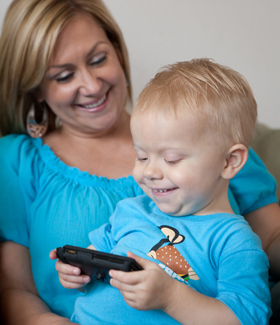
Luke Tanner, who received state-of-the-art care in Rady Children’s Bernardy Center for Medically Fragile Children and through the Rady Children’s Solid Organ Transplant Program, reacts to pictures of his brothers on a smartphone, while his mom Leah enjoys the moment.
Leah Kent, a 40-year-old single mother of five children, knew something was terribly wrong with her baby, Luke. He had an extremely large abdomen and his development was far behind her four older children. At 5 months of age, he couldn’t hold his neck and head up when she held him.
In December 2008, Luke’s pediatrician referred him to Bruce Barshop, M.D., Ph.D., director of Metabolic Genetics at Rady Children’s Hospital-San Diego. Dr. Barshop suspected Luke had an inherited disease called Glycogen Storage Disease type IV (GSD-IV), a disease that destroys the liver and is usually fatal by age 5.
There are several forms of GSD, but all patients have an absence or deficiency of one of the enzymes responsible for making or breaking down glycogen, a main energy source for the body. Dr. Barshop sees 10 or more children a year with type I, II and III GSD, but Luke is the only child with type IV in San Diego. The overall frequency for all forms of Glycogen Storage Disease is approximately one in 20,000-25,000 live births.
“We had to do a liver biopsy to diagnose GSD,” Dr. Barshop explained. “From the biopsy, it was clear he was storing carbohydrates, and I was pretty sure it was type IV GSD because he didn’t have the features of other types in his blood chemistry.”
Because the liver sample had to be sent for enzyme testing, it took until March 2009 to confirm Luke’s diagnosis — and the clock was ticking.
“This is a progressive disease that ends with liver failure,” Dr. Barshop said. “We put him on a deceased donor liver transplant waiting list right away.”
Leah and Luke’s father, Stuart Witt, were devastated by the diagnosis. They also learned they both have a recessive gene that caused their son’s disease.
Leah credits Keith Vaux, M.D., a Rady Children’s birth defects and pediatric hospital medicine specialist, for getting Luke placed in Rady Children’s Bernardy Center for Medically Fragile Children — and keeping him alive prior to the transplant.
“Luke was very ill and they were afraid he would have seizures,” she said. “They didn’t know what to expect medically because this disease is so rare. His liver was several times the normal size for a child his age.”
Dr. Barshop said Luke deteriorated very quickly and they knew he would die without a transplant. Fortunately, Leah’s liver was compatible to Luke’s blood type so she could donate a part of hers.
Immediately after determining the compatibility, a surgical team was formed, including Ajai Khanna, M.D., Ph.D., program director of the Solid Organ Transplant Program at Rady Children’s, and Karen Kling, M.D., a Rady Children’s pediatric solid organ transplant surgeon. On July 27, 2009, Leah and Luke were operated on simultaneously, with Dr. Khanna and Dr. Kling operating on Luke, and Marquis Hart, M.D., a former University of California, San Diego (UC San Diego) transplant surgeon, operating on Leah. Leah’s surgery took about three hours and Luke’s was eight hours long.
“The last time I saw Luke before the surgery his skin was turning black from liver failure,” Leah said. “But when I woke up from the transplant, he was pink again like a normal, healthy child — it was so amazing.”
Luke did, however, have one complication after the transplant. “He had a blockage in his blood vessel and we had to take him back to the operating room to fix it, but we picked it up early and fixed it quickly,” Dr. Khanna said.
Rady Children’s Solid Organ Transplant Program, which was brought to Rady Children’s by UC San Diego in 2001, is one of the top-rated programs of its kind in the country. To date, Dr. Khanna and his team have performed more than 80 kidney and 50 liver transplants.
“I believe it is the state-of-the-art facilities at the Hospital, a multidisciplinary team of specialists, pediatricians, physicians in other disciplines and the wonderful working nursing staff who cares for patients coupled with a committed administration that makes this a top-notch system,” Dr. Khanna said.
Luke turned 2 on August 3 this year and is a happy little boy, even though he has to take medicine every day to prevent rejection of his new liver. He also can’t go out in crowded places because of his susceptibility to germs but, other than that, he is developing normally.
“I can’t say enough about the entire metabolic and GI teams — they were outstanding,” Leah said. “And of course there is the Transplant Team and all the wonderful doctors and nurses that cared for both of us after the transplant.”
Said Dr. Khanna, “Mom came forward and saved her own son by sacrificing some of her own liver — that’s a phenomenal commitment to her baby.”
Dr. Barshop is doing clinical research on GSD at Rady Children’s. Additionally, Luke’s case will be written up as a case study to be published in a national medical journal.
The San Diego Union-Tribune Kids’ Newsday, October 2010